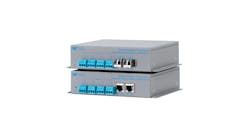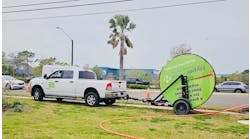Latest from Home
To describe how longitudinal balance of a cable pair affects the circuit let’s look back in time. The first telephone circuits were telegraph lines or open wire (one-wire) circuits with ground as a return. In the late 1800s, electric streetcars were used in many cities. Because there was zero longitudinal balance on a one-wire circuit, unwanted frequencies and power influence (noise to ground) rendered the circuit useless.
To solve the problem, the telephone companies converted to balanced circuits (tip and ring), which also reduced attenuation increasing the distance for telephone circuit. But, 2 wires strung side-by-side sharing the ground with power lines showed an increase of interference. Because of this interference, telephone engineers devised a method of transposition (twist) to balance the circuits.
Most multifunctional test sets provide a longitudinal balance test when testing cable pairs. When testing any cable pair for acceptable longitudinal balance, any indication that is greater than 60dB indicates that the circuit is longitudinally balanced. What does that mean?
It means that at any given microsecond there are countless AC signals at different frequencies at different amplitudes in different phases traveling back and forth along a copper cable pair when that circuit is transporting bandwidth. Wanted AC frequencies are traveling back and forth diametrically opposed on tip and ring conductors while unwanted AC frequencies are traveling back and forth in phase on tip and ring conductors.
Wanted AC frequencies that are transported back and forth diametrically opposed are picked up by end-user equipment such as a modem synced to a digital subscriber line access multiplexer (DSLAM). At the same time unwanted AC frequencies that are traveling back and forth in the same phase such as power influence (sometimes called noise to ground) do not affect end-user equipment unless they get too high in amplitude.
If a cable pair has good longitudinal balance, the AC signals, both wanted and unwanted, flow back and forth along tip and ring. No signal from any frequency at any amplitude in any phase should travel from the tip to the ring or from the ring to the tip along the route.
If the cable pair has poor longitudinal balance, AC signals will travel from the tip to ring or from ring to tip along the route. If the unwanted signals inadvertently traveling along the route from the ring to the tip conductor, or from the tip to the ring conductor have enough amplitude, bandwidth on that circuit will be affected.
Testing a Cable Pair for AcceptableLongitudinal Balance
Longitudinal balance is accomplished with good pair balance on a vacant pair. Pair balance is broken down to 2 parts: capacitive balance, and resistive balance.
To test for resistive balance place a zero ohm grounded short on one end of the circuit (perhaps at the Central Office or remote).
Then, go to the other end of the circuit (perhaps the network interface) and connect to the pair at the drop wire with the ground lead of the test set connected to the network interface ground.
First measure tip to ring ohms and then tip and ring to ground ohms. Tip and ring to ground should measure ½ the tip to ring resistance and should be equal. For example, if tip to ring ohms measured 200 ohms, then tip and ring to ground should measure 100 ohms and be of equal resistance. As little as 5 ohms difference between tip to ground and ring to ground will fail the resistive balance test and the longitudinal balance test.
If the pair fails the longitudinal balance test (< 60dB) look for:
- Crossed battery from another circuit on the ring or tip of the pair.
- A ring or tip ground on the cable pair. (A tip to ring short will not affect the longitudinal balance.)
- Series resistance on the ring or tip of the pair.
Test Procedure for Acceptable Capacitive Balance on the Cable Pair
- First open the pair at one end and connect an open meter to the other end of the cable pair.
- Next, measure the capacitance converted to feet or meters tip to ground and ring to ground. Tip to ground and ring to ground measurements should show equal distance indicating that the pair is 100 percent capacitively balanced.
- If tip to ground measure differently, divide the shorter measurement by the longer measurement. This will give you a percentage of balance between the tip and ring conductor.
- The capacitive balance must be greater than 98% to pass the longitudinal balance test.
If a pair fails the longitudinal balance test due to an unacceptable capacitive balance look for:
- The pair open on the tip or ring conductor only.
- The pair open on one side of a lateral.
- The pair open one side on a bridged tap beyond the end users terminal or pedestal.
- The tip or ring of the pair is crossed with a non-working conductor.
Signing off
There is so much more to be said about this topic. If you are interested, bring it up on the LinkedIn group Copper Infrastructure and Outside Plant Technical Challenges: https://www.linkedin.com/groups/Copper-Infrastructure-Outside-Plant-Tech…. The LinkedIn group is a great place to engage in discussions with other technicians. If you want to contact me with comments and thoughts on topics you’d like me to write about, contact me at [email protected]; or call 831.818.3930, and check out my website: www.mccartyinc.com.





